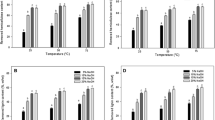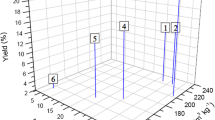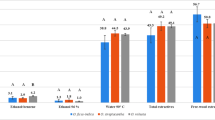Abstract
Corn fiber (CF) is an agroindustrial residue obtained from starch or corn syrup. Currently, there has been increasing research interest in lignocellulosic materials from these residual materials. Consequently, this paper is a novel approach that complements the structural and chemical characterizations already published in the literature for CF. In this study, isolation, chemical composition and characterization was conducted of hemicellulose by means of 1H NMR and FTIR-ATR and Klason lignin by means of acid soluble lignin (ASL) and acid insoluble lignin (AIL) determination using UV spectrophotometry and Py–GC‒MS. Hemicellulose was obtained after aqueous extraction, lipid removal, delignification and alkaline extraction. The isolated hemicellulose from CF confirmed the presence of arabinoxylan, which was similar to the results reported in the literature. The CF contained 8.0% and 4.0% ASL and AIL, respectively. Regarding lignin, the study identified more than 47 primary pyrolysis products for ASL, with 17%, 20% and 59% relative molar abundance for lignin, carbohydrates, and other products, respectively, and 39 primary pyrolysis products with 44% and 7% relative molar abundance for lignin and carbohydrates, respectively. The main products derived from lignin were phenol, 4-methylphenol, guaiacol, 4-vinilguaiacol, syringol and syringylaldehyde. The peaks of lignin derivatives indicated that the Klason method is effective for lignin isolation, and the Py–GC‒MS technique allowed for the identification of the presence of residual lignin in AIL and ASL from CF. In this context, lignocellulosic components of CF are chemically suitable for use as raw materials to transform biomass into high value-added products.
Graphical abstract






Similar content being viewed by others
Data availability
The datasets generated during and/or analyzed during the study are available in the Federal University of Viçosa repository for doctorate theses and for master’s theses.
References
Alén R, Kuoppala E, Oesch P (1996) Formation of the main degradation compound groups from wood and its components during pyrolysis. J Anal Appl Pyrol 36:137–148. https://doi.org/10.1016/0165-2370(96)00932-1
Álvarez C, González A, Negro MJ, Ballesteros I, Oliva JM, Sáez F (2017) Optimized use of hemicellulose within a biorefinery for processing high value-added xylooligosaccharides. Ind Crops Prod 99:41–48. https://doi.org/10.1016/j.indcrop.2017.01.034
Anglès MN, Reguant J, Martinez JM, Farriol X, Montane D, Salvado J (1997) Influence of the ash fraction on the mass balance during the summative analysis of high-ash content lignocellulosics. Bioresour Technol 59:185–193. https://doi.org/10.1016/S0960-8524(96)00149-6
Barbosa BM, Colodette JL, Longue-Junior D, Gomes FJB, Martino DC (2014) Preliminary studies on furfural production from lignocellulosics. J Wood Chem Tech 34:178–190. https://doi.org/10.1080/02773813.2013.844167
Barbosa BM, Colodette JL, dos MuguetS MC, Gomes V, Oliveira RC (2016) Effects of xylan in eucalyptus pulp production. Cerne 22:207–214. https://doi.org/10.1590/01047760201622022102
Barbosa BM, Lino AG, de Aguiar AR, de F de FB, Gomes FJB, da Silva JC, Colodette JL (2018) Addition of corn fiber xylan to eucalyptus and pinus pulp and its effect on pulp bleachability and strength. Nord Pulp Pap Res J 33:414–419. https://doi.org/10.1515/npprj-2018-3060
Barbosa BM, Vaz S, Colodette JL et al (2022) Effects of kraft lignin and corn residue on the production of eucalyptus pellets. Bioenerg Res. https://doi.org/10.1007/s12155-022-10465-7
Bartos L, Prchal V, Rajcova A, Ebringerova A, Gregorova A (1990) Rheological properties of hemicelluloses (in Slovak). Text Chem 20:37–48
Beramendi-Orosco LE, Castro-Diza M, Snape CE, Vane CH, Large DJ (2004) Application of catalytic hydropyrolysis for the rapid preparation of lignin concentrates from wood. Org Geochem 35:61–72. https://doi.org/10.1016/j.orggeochem.2003.07.001
Boerjan W, Ralph J, Baucher M (2003) Lignin biosynthesis. Annu Rev Plant Biol 54:519–546. https://doi.org/10.1146/annurev.arplant.54.031902.134938
Boschetti WTN, Carvalho AMML, Carneiro ACO, Santos LC, Poyares LBQ (2019) Potential of kraft lignin as an additive in briquette production. Nord Pulp Pap Res J 34:147–152. https://doi.org/10.1515/npprj-2018-0002
Brumano GC, Colodette JL, Fernandes SA, Barbosa BM, Gomes FJB (2020) Investigation of eucalypt and pine wood acid-soluble lignin by Py-GC-MS. Holzforschung 74:149–155. https://doi.org/10.1515/hf-2018-0219
Cornelius BTLL, Ta YW (2021) A review on solvent systems for furfural production from lignocellulosic biomass. Renew Sust Energ Rev. https://doi.org/10.1016/j.rser.2020.110172
de Mattos NR, Colodette JL, de Oliveira CR (2019) Alkaline extraction and carboxymethylation of xylans from corn fiber. Cellulose 26:2177–2189. https://doi.org/10.1007/s10570-018-02236-5
de Morais CD, Abad AM, Evtuguin DV, Colodette JL, Lindström M, Vilaplana Sevastyanova O (2017) Isolation and characterization of acetylated glucuronoarabinoxylan from sugarcane bagasse and straw. Carbohydr Polym 56:223–234. https://doi.org/10.1016/j.carbpol.2016.09.022
del Río JC, Gutiérrez A, Hernando M, Landín P, Romero J, Martínez AT (2005) Determining the influence of eucalypt lignin composition in paper pulp yield using Py-GC/MS. J Anal Appl Pyrol 74:110–115. https://doi.org/10.1016/j.jaap.2004.10.010
del Río JC, Gutiérrez A, Rodríguez IM, Ibarra D, Martinez AT (2007) Composition of non-woody plant lignins and cinnamic acids by Py–GC/MS, Py/TMAH and FT-IR. J Anal Appl Pyrolysis 7:39–46. https://doi.org/10.1016/j.jaap.2006.09.003
del Río JC, Lino AG, Colodette JL, Lima CF, Gutiérrez A, Martine AT, Fachunang L, Ralph J, Rencoret J (2015) Differences in the chemical structure of the lignins from sugarcane bagasse and straw. Biomass Bioenergy 81:322–338. https://doi.org/10.1016/j.biombioe.2015.07.006
Deutschmann R, Dekker RFH (2012) From plant biomass to bio-based chemicals: latest developments in xylan research. Biotechnol Adv 30:1627–1640. https://doi.org/10.1016/j.biotechadv.2012.07.001
Egüés I, Stepan AM, Eceiza A, Toriz G, Gatenholm P, Labidi J (2014) Corncob arabinoxylan for new materials. Carbohydr Polym 102:12–20. https://doi.org/10.1016/j.carbpol.2013.11.011
Gillet S, Aguedo M, Petijean L, Morais ARC, da Costa LAM, Łukasik RM, Anastas PT (2017) Lignin transformations for high value appliations: towards targeted modifications using green chemistry. Green Chem 19:4200–4233. https://doi.org/10.1039/C7GC01479A
Goldschmid O (1971) Ultraviolet spectra, In: Lignins: occurrence, formation, structure and reactions, Sarkanen, KV, Ludwig CH (Eds), Wiley-Interscience, New York, pp 241–266
Gomes FJB, Colodette JL, Burnet A, Batalha LAB, Santos FA, Demunier IF (2015) Thorough characterization of Brazilian new generation of eucalypt clones and grass for pulp production. IJFR Hindawi Publishing Corporation, Cairo, p 10p. https://doi.org/10.1155/2015/814071
Guo W, Heeres HJ, Yue J (2019) Continuous synthesis of 5-hydroxymethylfurfural from glucose using a combination of AlCl3 and HCl as catalyst in a biphasic slug flow capillary microreactor. Chem Eng J 381:122754. https://doi.org/10.1016/j.cej.2019.122754
International Dairy Federation (1993) Standards 20 B. MILk. Determination of nitrogen content. Brussels: IDF. 30
Kálmán G, Recseg K, Gaspar M, Réczey K (2006) Novel approach of corn fiber utilization. In: twenty-seventh symposium on biotechnology for fuels and chemicals. Humana Press, New York, pp 738–750
Kawamoto H (2017) Lignin pyrolysis reactions. J Wood Sci 63:117–132. https://doi.org/10.1007/s10086-016-1606-z
Khaire KC, Maibam PD, Thakur A, Goyal A (2022) Biomedical and pharmaceutical applications of xylan and its derivatives. In: Brienzo M (eds) Hemicellulose biorefinery: a sustainable solution for value addition to bio-based products and bioenergy. Clean Energy Production Technologies. Springer, Singapore. https://doi.org/10.1007/978-981-16-3682-0_14
Leathers TD (1998) Upgrading fuel ethanol components. SIM Ind Microbiol News 48:210–217
Lichnerova´I, Ebringerova´ A, Heinrich J, (1991) Xylans; perspective pharmaceutical auxiliary materials. Acta Fac Pharm (bratislava) 45:5–141
Lili W, Yijun J, Chunhu L et al. (2011) Microwave-assisted hydrolysis of corn cob for xylose production in formic acid. Materials for renewable energy & environment (ICMREE), Shanghai, China, May 20–22
Lima CF, Barbosa LCA, Ribeiro MC, Silverio FO, Colodette JL (2008) Comparison between analytical pyrolysis and nitrobenzene oxidation for determination of syringyl/guaiacyl ratio in Eucalyptus spp. lignin. BioResources 3:701–712
Lin SY, Dence CW (1992) Methods in lignin chemistry. Springer-Verlag, Berlin, p 578
Liu L, Chang HM, Jameel H, Park S (2018) Furfural production from biomass pretreatment hydrolysate using vapor-releasing reactor system. Bioresour Technol 252:165–171. https://doi.org/10.1016/j.biortech.2018.01.006
Lourenço A, Gominho J, Pereira H (2018) Chemical characterization of lignocellulosic materials by analytical pyrolysis. Peter Kusch (Ed), IntechOpen. https://doi.org/10.5772/intechopen.80556. Available from https://www.intechopen.com/books/analytical-pyrolysis/chemical-characterization-of-lignocellulosicmaterials-by-analytical-pyrolysis
Lu Y, He Q, Fan G, Cheng Q, Song G (2021) Extraction and modification of hemicellulose from lignocellulosic biomass: a review. Green Process Synth 10:779–804. https://doi.org/10.1515/gps-2021-0065
Mansilla HD, Baeza J, Urźua S, Maturana G, Villaseńor J, Duráan N (1998) Acid-catalysed hydrolysis of rice hull: evaluation of furfural production. Bioresour Technol 66:189–193
Moldoveanu SC (2010) Techniques and instrumentation in analytical chemistry. Chapters 6: pyrolysis of carbohydrates, Moldoveanu SC (Ed). Elsevier, New York, NY, USA. pp 419–470
Paes MCD (2007) Manipulação da composição química do milho: impacto na indústria e na saúde humana Embrapa digital, pp 1–6. https://ainfo.cnptia.embrapa.br/digital/bitstream/item/50216/1/Manipulacao-composicao.pdf. Accessed 26 Feb 2022
Peng F, Bian J, Ren JL, Peng P, Xu F, Sun RC (2012) Fractionation and characterization of alkali-extracted hemicelluloses from peashrub. Biomass Bioenergy 39:20–30. https://doi.org/10.1016/j.biombioe.2010.08.034
Ralph J, Hatfield RD (1991) Pyrolysis-GC-MS characterization of forage materials. J Agric Food Chem 39:1426–1437
Ren JL, Sun RC, Liu CF, Coa ZN, Luo W (2007) Acetylation of wheat straw hemicelluloses in ionic liquid using iodine as a catalyst. Carbohydr Polym 70:406–414. https://doi.org/10.1016/j.carbpol.2007.04.022
Sánchez C, Serrano L, Andres MA, Labidi J (2013) Furfural production from corncobs autohydrolysis liquors by microwave technology. Ind Crops Prod 42:513–519. https://doi.org/10.1016/j.indcrop.2012.06.042
Scott RW (1979) Colometric determination of hexuronic acids in plant materials. Anal Chem 7:936–941
Sihtola H, Blomberg L (1975) Hemicelluloses precipitated from steeping liqour in the viscose process as additives in papermaking. Cellul Chem Technol 9:555–560
Silva JC, Oliveira RC, Neto AS, Pimentel VC, Santos AA (2015) Extraction, addition and characterization of hemicelluloses from corn cobs to development of paper properties. Proc Mater Sci 8:793–801. https://doi.org/10.1016/j.mspro.2015.04.137
Silva SS, Carvalho RR, Fonseca JL, Garcia RB (1998) Extraction and characterization of corn cob xylanes. Polímeros: Ciência e Tecnologia, Apr/Jun, 25–33
Silvério FO, Barbosa LCA, Veloso DP (2008) Pyrolysis as analytic technique. Quim Nova 31:1553–1561. https://doi.org/10.1590/S0100-40422008000600045
Sindimilho (2005) Sindicato da Industria de Milho, Soja e seus derivados no Estado de São Paulo; Milho e suas riquezas, História. www.fiesp.com.br/sindmilho/curiosidades. Accessed 28 Feb 2022
Sjöberg J, Kleen M, Dahlman O, Agnemo R, Sundvall H (2002) Analysis of carbohydrate and lignin in the surface and inner layers of softwood pulp fibers obtained employing various alkaline cooking process. Nord Pulp Pap Res J 17:295–301
Solár R, Kacik F, Melcer I (1987) Simple method for determination of O-acetyl groups in wood and related materials. Nord Pulp Pap Res J 4:139–141
Stepan AM, Höije A, Schols HA, de Waard P, Gatenholm P (2012) Arabinose content of arabinoxylans contributes to flexibility of acetylated arabinoxylan films. J Appl Poly Sci 125:2348–2355. https://doi.org/10.1002/app.36458
Song X, Chen F, Liu S (2016) A lignin-containing hemicellulose-based hydrogel and its adsorption behavior. BioResources 11:6378–6392
Sun RC, Tomkinson J (2002) Characterization of hemicelluloses obtained by classical and ultrasonically assisted extractions from wheat straw. Carbohydr Polym 50:263–271
Sun XF, Sun RC, Zhao L, Sun JX (2004) Acetylation of sugarcane bagasse hemicelluloses under mild reaction conditions by using NBS as a catalyst. J Appl Polym Sci 92:53–61
Sun Y, Wang Z, Liu Y, Meng X, Qu J, Liu C, Qu B (2020) A Review on the transformation of furfural residue for value-added products. Energies 13:21. https://doi.org/10.3390/en13010021
Swan B (1965) Isolation of acid-soluble lignin from the Klason lignin determination. Svensk Papperstidn 68:791–795
Tappi standard (1997) T264 cm-97, Preparation of wood for chemical analysis
Tappi standard (2007) T204 cm-07, Extractives in acetone
Tappi standard (2011a) T222 cm-11, Acid-insoluble lignin in wood and pulp
Tappi standard (2011b) UM 250, Acid-soluble lignin in wood and pulp
Tappi standard (2011c) T211 om-12, Ashes
Technical Association of the Pulp and Paper Industry (1997) TAPPI Test Method T 264 cm-22. Preparation of wood for chemical analysis. https://www.tappi.org/publications-standards/standards-methods/standardsonline/. Accessed 4 Aug 2022
Technical Association of the Pulp and Paper Industry (2007) TAPPI Test Method T 204 cm-07. Solvent extractives of wood and pulp. https://www.tappi.org/publications-standards/standards-methods/standardsonline/. Accessed 4 Aug 2022
Technical Association of the Pulp and Paper Industry (2011a) TAPPI Test Method T 222 om-11. Acid-insoluble lignin in wood and pulp. https://www.tappi.org/publications-standards/standards-methods/standardsonline/. Accessed 4 Aug 2022
Technical Association of the Pulp and Paper Industry (2011b) TAPPI Test Method UM 250. Acid-soluble lignin in wood and pulp. https://www.tappi.org/publications-standards/standards-methods/standardsonline/. Accessed 04 Aug 2022
Technical Association of the Pulp and Paper Industry (2011c) TAPPI Test Method T211 om-12. Ash in wood, pulp, paper and paperboard: combustion at 525 oC. https://www.tappi.org/publicationsstandards/standards-methods/standardsonline/. Accessed 04 Aug 2022
United States Department of Agriculture (2022). Accessed in 28 March 2022
Van Dongen FEM, Van Eylen D, Kabel MA (2011) Characterization of substituents in xylans from corncobs and stover. Carbohydr Polym 86:722–731. https://doi.org/10.1016/j.carbpol.2011.05.007
Vaz Jr S (Ed). (2016) Analytical techniques and methods for biomass, Springer Nature, Cham
Vaz Jr S (Ed) (2018) Biomass and green chemistry—building a renewable pathway. Springer Nature, Cham
Wallis A, Wearne R, Wright P (1996) Chemical analysis of polysaccharides in plantation eucalyptus wood and pulps. Appita J 49:258–262
Watson SA (1987) Structure and composition. In: corn: chemistry and technology. Watson SA, Ramstad PE (eds). Am Assoc Cereal Chem, St. Paul, MN, pp 53–82
Yasuda S, Murase N (1995) Chemical structures of sulfuric acid lignin. XII. Reaction of lignin models with carbohydrates in 72% H2SO4. Holzforschung 49:418–422
Yasuda S, Fukushima K, Kakehi A (2001) Formation and chemical structures of acid-soluble lignin I: sulfuric acid treatment time and acid-soluble lignin content of hardwood. J Wood Sci 47:69–72
Zier N, Schiene R, Fischer K (1997) Structural characterization of an organosolv lignin by analytical pyrolysis and wet chemical degradation methods. J Anal Appl Pyrolysis 40:525–551
Funding
This work was supported by the Brazilian Coordination for the Improvement of Higher Education Personnel (CAPES) (Biorefinery of Lignin Project; EMBRAPA-CAPES 2014 Joint Call).
Author information
Authors and Affiliations
Contributions
BMB—experiments for her PhD thesis and manuscript draft. SVJr—manuscript review and submission; BMB thesis cosupervision. JLC—BMB thesis supervision. ARdeA—manuscript review and assistance during the experiment. CPTC—manuscript review. BdeFHdeF—manuscript review and assistance during the experiment.
Corresponding author
Ethics declarations
Conflict of interest
The authors have no relevant financial or nonfinancial interests to disclose.
Additional information
Publisher's Note
Springer Nature remains neutral with regard to jurisdictional claims in published maps and institutional affiliations.
Rights and permissions
Springer Nature or its licensor holds exclusive rights to this article under a publishing agreement with the author(s) or other rightsholder(s); author self-archiving of the accepted manuscript version of this article is solely governed by the terms of such publishing agreement and applicable law.
About this article
Cite this article
Barbosa, B.M., Vaz, S., Colodette, J.L. et al. Structural and chemical characterization of lignin and hemicellulose isolated from corn fibers toward agroindustrial residue valorization. Cellulose 29, 8117–8132 (2022). https://doi.org/10.1007/s10570-022-04769-2
Received:
Accepted:
Published:
Issue Date:
DOI: https://doi.org/10.1007/s10570-022-04769-2




